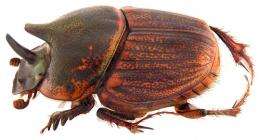March 4, 2010 report
Female dung beetles use horns to fight over manure

(Â鶹ÒùÔºOrg.com) -- Dung beetles are among the few species in which the females are more impressively equipped with armor than males, and a new study explains why: the females fight each other for the best manure and breeding sites.
University of Western Australia researchers, Prof. Leigh Simmons and Dr. Nicola Watson, studied the female dung beetle (Onthophagus sagittarius), which, as its name suggests, feeds on dung. When they arranged for the females to have to race each other to reach deposits of cow dung and access to egg-laying sites in tunnels beneath the dung, those with larger horns were able to gather more manure, and thus provide more of this valuable resource for supporting their young.
In a study published in the Proceedings of the Royal Society B, the researchers said competition between females for the use of breeding resources reduced the reproductive fitness of all the beetles, but smaller beetles were worse off than larger individuals. When matched for body size, the longest horns gave the greatest advantage in reproductive fitness, producing significantly more broods than beetles with shorter horns.
Dung beetles lay their eggs in balls of dung, which must be fresh for the beetles to use it and this is what leads to competition. Watson said there is a distinct advantage for females that can get to dung first and seize the best and freshest pieces. They have also been observed stealing dung from other females and replacing eggs with their own.
Dung beetles are also unusual in that the female dung beetles’ horns are of a different type to those of male beetles, and the scientists suggest this means they have evolved independently. Unlike male horns, they are not used for fighting off predators, defending territory, or competing for mates, but for fighting off other females competing with them for resources.
More information: Reproductive competition promotes the evolution of female weaponry, Nicola L. Watson, Leigh W. Simmons; Proceedings of the Royal Society B.
© 2010 Â鶹ÒùÔºOrg.com


















